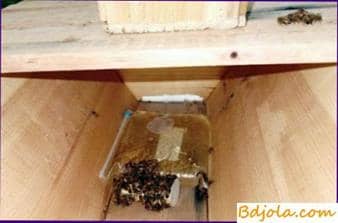
Bees can live for a long time, eating pure sugar syrup, but they can not grow brood, allocate wax, intensively collect nectar and perform many other works, because sugar is a purely carbohydrate food and does not contain other substances vital for bees.
Replenishment of fodder stocks.
With a lack of honey in hives in the spring, bees are usually fed with sugar. In a number of countries, beekeepers in autumn select a significant part of the forage from the hives, in return they give sugar syrup, which (instead of honey) the bees are forced to eat in the spring. How does this change affect the livelihoods of bee colonies in the active season?
At the Institute of Apiculture, an experiment was conducted comparing the growth and productivity of bee colonies fed with honey and sugar. For the experiment, 20 bee colonies were identified, which were divided into two equivalent groups. The families of the first group had honey in the nests in the spring, which they fed the whole period to the honey crop. As the consumption of honey in the nest of bees substituted for new honeycomb honey. The families of the second group had from the spring the same amount of dense sugar fodder, which also, as it was consumed, was added. Families of both groups freely contributed to the beehive. During the spring 4 times (every 12 days), the number of brood rearing by families was calculated (Table 18).

Before the start of the honey harvest, families who ate sugar syrup fed on 12.7% less brood, and during the main honey harvest they collected 24.6% less honey; this indicates that the sugar in its nutritional value is much inferior to natural honey. Therefore, to feed bees with sugar for the spring replenishment of fodder stocks should be only in those cases when it is not possible to leave a sufficient number of honeycombs from the autumn with printed honey.
To replenish fodder stocks in the spring, bee families are given thick food (for 1 liter of water 2 kg of sugar) and large portions (4-6 liters), so as not to disturb families again.
Typically, this event is conducted in the evening (at night), which reduces the aimless departures and losses of bees in relatively cool or windy weather. When
This feeder should be securely sheltered and the tray reduced.
Spent fertilizing with sugar.
The presence of nectar and pollen in nature is one of the most significant factors causing an increase in the number of brood grown in families. However, in the spring, the collection of nectar is very often short and unstable. In most places, nectar is not found in nature in the most critical period of bees growing to the main honey collector. Therefore, long ago beekeepers sought to create in the spring artificial bees artificial honey. To this end, the bees were fed in small portions – 1-2 cups a day or a day later of diluted honey (1 kg of honey in 0.5 liters of water – honey), or liquid sugar syrup (1 kg of sugar in 1 liter of water).
To test the effectiveness of the stimulating feeding with honey or sugar, a large number of experiments were carried out. Since spring, two equal groups of bee colonies have been selected. The families of one group were given daily (or every other day) 1-2 glasses of diluted honey or liquid sugar syrup. The families of the second group were not given top dressing, and the bees were content with the honey reserves available in the nest. All families were equally able to collect nectar and pollen in nature. At the beginning of the experiment, when selecting equal groups, and at the end of the experiment, the number of broods grown in the families of both groups was counted.
In all experiments, families, fed with small portions of sugar syrup, raised brood no more than control families who did not receive fertilizing.
The stimulating top dressing with small portions of honey or sugar syrup does not increase the amount of brood that is grown, although it undoubtedly activates bees: the years of bees increase, and in some cases pollen.
Препарат для опыления томатов ту. Вино пчелам.
Feeding base of beekeeping